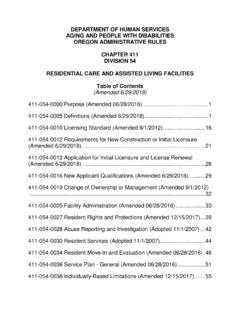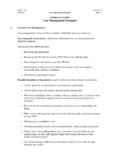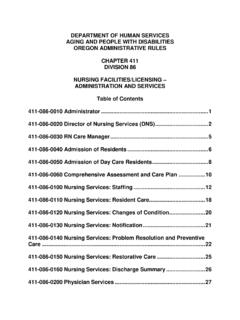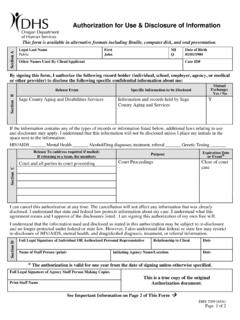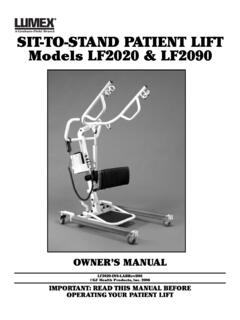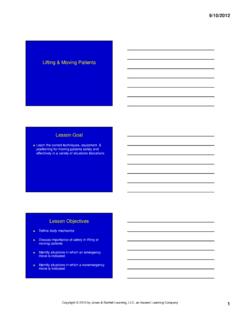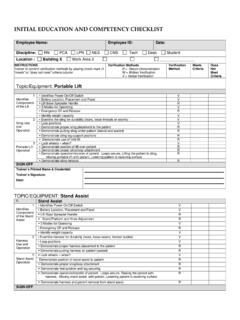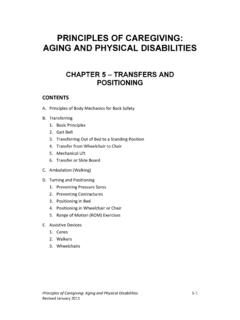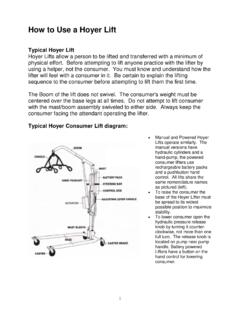Transcription of Lifting and Positioning Training - dhs.state.or.us
1 SOCP Lift and Positioning Training 1 (05/10) Appendix C Lifting and Positioning Training (Equipment Specific) Behavior Specialist Manual Behavior Specialist Manual SOCP Lift and Positioning Training 2 (05/10) Table of Contents Purpose of this Training .. 3 Lifting and Positioning Overview .. 3 Safe Client Handling and 4 Safe Client Handling and Movement: .. 6 Mechanical Lifts: Hoyer .. 7 The Sling .. 8 Positioning equipment .. 12 SOCP Lift and Positioning Training 3 (05/10) Purpose of this Training 1. Define correct body mechanics and posture when Lifting /transferring / Positioning clients 2. Identify and prevent environmental risks factors that can lead to client/staff injuries while Lifting / Positioning 3.
2 Understand and demonstrate correct use of Lifting devices 4. Understand and demonstrate correct use of Positioning /mobility devices Note: This Training provides equipment-specific instructions for operating Lifting and Positioning /mobility devices. These instructions will apply to all of the individuals who utilize these devices. However, some clients may require special considerations that are in addition to the following operating instructions. These considerations are detailed in the client s individual profiles. The development of this Training manual was informed and guided by the following: Health Care Hazards Module, Back Injury Guide for Health Care Providers (California OSHA branch), Ergonomic Guidelines for Nursing Homes (all developed by the Occupational Safety and Health Administration (OSHA) at ), Client Care Ergonomics Resource Guide: Safe Client Handling and Movement, developed by the Client Safety Center of Inquiry (Tampa, FL), Veterans Health Administration and Department of Defense, the Guidance of Safe Moving of Clients, issued by the Occupational Health and Safety Commissioner, and SOCP zero Lifting policy.
3 Lifting and Positioning Overview Many of the clients living at SOCP require staff assistance with Lifting , moving and handling ( being turned during the night, being lifted in and out of bed, transferring from a seat to a wheelchair or from a wheelchair to a toilet, being pushed in a wheelchair and so on). The sheer volume of these activities can lead to fatigue, muscle strain and injury. To ensure the continued safety and health of the individuals living at SOCP, as well as the staff, SOCP is committed to a zero- Lifting policy of not manually Lifting or transferring clients unless there is no alternative. The goal of the zero-lift program is to create a safer environment for staff and individuals, reduce the physical strain needed to perform Lifting tasks and improve the level of care offered in the homes.
4 Mechanical Lifts: A key component to complying with SOCP s zero-lift policy is the utilization of mechanical lifts. Currently, SOCP primarily utilizes the Hoyer for these types of lifts. Understanding how to correctly operate these mechanical lifts is key to ensuring the health and safety of clients and staff and will greatly reduce the prevalence of injuries. Positioning Equipment: Many of the clients at SOCP utilize a variety of Positioning equipment from sidelyers to crawligators. Utilizing this equipment helps to counteract medical problems like weight gain, constipation, muscle contractures, and skin breakdown. In addition, some of the equipment promotes opportunities for the clients to experience self SOCP Lift and Positioning Training 4 (05/10) initiated movement and gain benefits in the areas of cognition, self esteem, and environmental awareness.
5 As with the use of mechanical lifts, understanding how to correctly operate and utilize the various Positioning equipment is key to ensuring the health and safety of clients and staff, will greatly reduce the prevalence of injuries, as well as, increase the client s overall quality of life. Safe Client Handling and Movement Maintaining correct body mechanics and posture Body Mechanics: Body mechanics is a term used to describe the ways we move as we go about our daily lives. It includes how we hold our bodies when we sit, stand , lift, carry, bend, and sleep. Poor body mechanics are often the cause of back problems. When we don t move correctly and safely, the spine is subjected to abnormal stresses that over time can lead to degeneration of spinal structures like discs and joints, injury, and unnecessary wear and tear.
6 The following are key body mechanic principles that are important to employ when Lifting /transferring/positing clients: Posture Good body mechanics are based on good posture. Good posture means the spine is in a "neutral" position - not too rounded forward and not arched back too far. To maintain good posture follow these few steps: stand with your feet apart. Create a small hallow in your lower back by tucking the tailbone in and tilting your pelvic bone slightly forward. Be careful not to arch too much. Pull the shoulders back and lift your chest. Lift your chin until it is level and relax your jaw and mouth. Being aware of your posture during all of your daily activities is the best way to ensure you are using good body mechanics. Pushing DO NOT D Push whenever possible: Keep head up Knees bent, and Back straight D Keep the load in front and use both hands D Remain close to the item being pushed U Pull when you can push U Twist your body U Learn forward SOCP Lift and Positioning Training 5 (05/10) Carrying objects DO NOT D When carrying objects: Test load first Use a transfer device whenever possible Pivot with your feet - don't twist at waist Take multiple trips Use both hands Keep objects near your body and directly in front of you Ask for assistance with heavy items U Carry with one hand U Twist body U Carry with a bent-over, stooped posture GET HELP IMMEDIATELY!
7 If items are too heavy. Reaching DO NOT D When reaching for an object: Keep back straight Reach with two hands Face the object stand on a stable step-stool to reach high items Bend knees slightly U Overreach by standing on toes U Reach with one hand U Twist at waist U stand on an unsafe surface U Reach with legs locked in straight position Lifting DO NOT D When Lifting objects, always: Use a mechanical lift device when feasible Keep objects close to your body and directly in front Keep feet at least shoulder width apart Test the load before Lifting Squat, bending your knees and hips Keep your head up and back straight Tighten stomach and lift with leg muscles Request help with heavy items U Lift in a bent-over, stooped position U Twist at waist U Lift with one hand U Lift with outstretched arms U Keep feet together U Lift above shoulders or below knees when feasible SOCP Lift and Positioning Training 6 (05/10) Safe Client Handling and Movement.
8 Identify and prevent environmental risk factors Prior to Lifting / Positioning a client, take the time to prepare the environment, organize the equipment and client, and finally, yourself. Prepare the environment: 9 Clear a working area 9 Eliminate any obstacles (chairs, tables, rugs) 9 Ensure adequate lighting 9 Ensure that the floor is dry 9 Minimize distracting noises Prepare the equipment: 9 Adjust position of the equipment (bed, sidelyer, wheelchair, hoyer, etc) 9 You may need to make adjustments to the client s wheelchair: include locking brakes, removing arm rests, and Positioning the wheelchair at an appropriate angle 9 You may need to make adjustments to the client s bed include locking brakes, putting down side rails, or adjusting bed height. 9 Ensure all devices are in good working order including belts, lifts, and slings.
9 Do the lift brakes work? Are any of the straps frayed on the sling? Is the lift battery charged? Do all of the buttons work on the lift? Is the lift making strange noises? Prepare the client: 9 Explain what you are about to do with the client 9 If necessary move/reposition any personal medical devices (IV tubing, etc.) Prepare yourself: 9 Discuss the plan with Lifting partners 9 Use simple instructions/one step commands 9 Be prepared for the unexpected. 9 Postpone the lift/transfer if the client is resistive, uncooperative or aggressive 9 Ask for help. Ask for help before you begin the move or transfer. While you wait for someone to come and help you with a transfer, finish preparing yourself, the environment and the client for the transfer, so when help comes, you are completely ready.
10 9 Know how to do the transfer that is being used. Is it safe? Can you do it safely? SOCP Lift and Positioning Training 7 (05/10) Mechanical Lifts: Hoyer Hoyer Lifts allow a person to be lifted and transferred with a minimum of physical effort. Before attempting to lift anyone practice with the lifter by using a helper, not the client. You must know and understand how the lifter will feel with a client in it. Be certain to explain the Lifting sequence to the client before attempting to lift them the first time. The Boom of the lift does not swivel. The client's weight must be centered over the base legs at all times. Do not attempt to lift client with the mast/boom assembly swiveled to either side. Always keep the client facing the attendant operating the lifter. Typical Hoyer Client Lift diagram: Manual and Powered Hoyer Lifts operate similarly.

